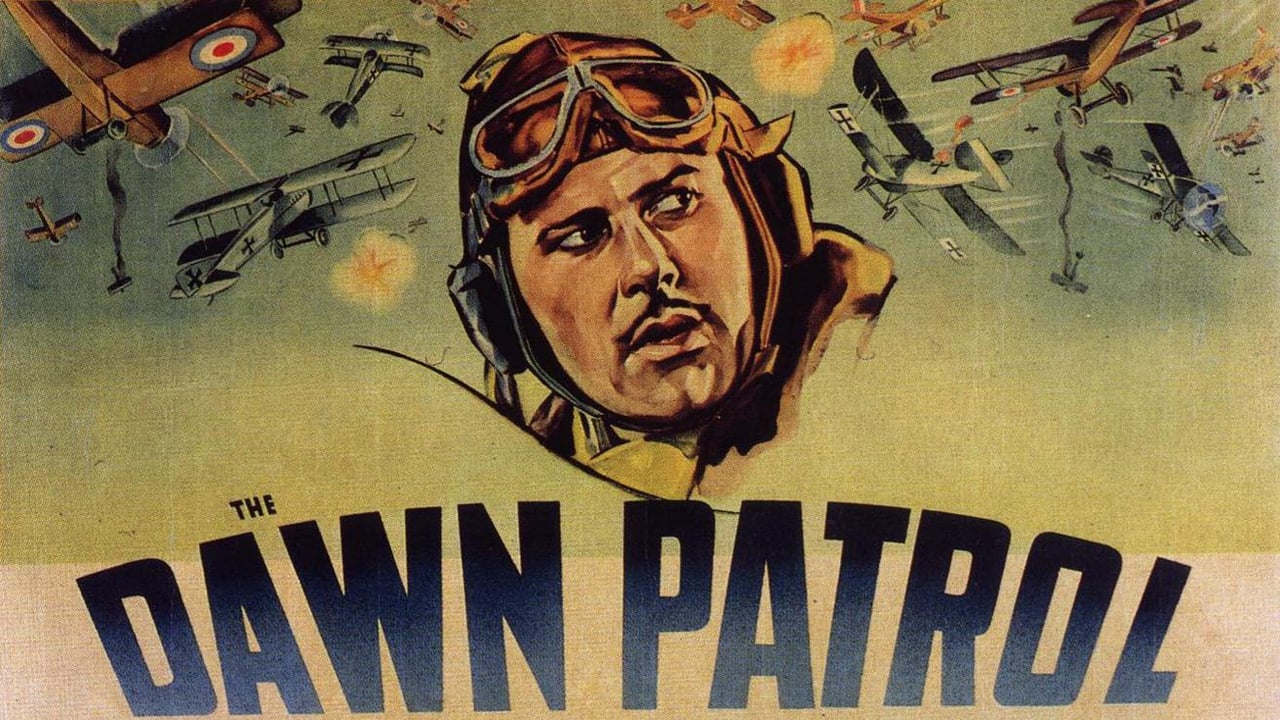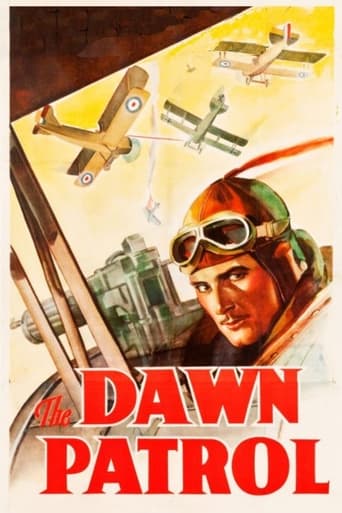Inclubabu
Plot so thin, it passes unnoticed.
Phonearl
Good start, but then it gets ruined
Derry Herrera
Not sure how, but this is easily one of the best movies all summer. Multiple levels of funny, never takes itself seriously, super colorful, and creative.
Zlatica
One of the worst ways to make a cult movie is to set out to make a cult movie.
HotToastyRag
Although I'm a classic movie aficionado and have seen more old movies than anyone I've ever met, I'd only ever seen Errol Flynn in a bit part in the Doris Day comedy It's a Great Feeling. So, for all intents and purposes, I'd never seen an Errol Flynn movie until I rented The Dawn Patrol. After only a few minutes of absorbing his performance, I was filled with awe and admiration. I haven't gone on a renting spree just yet, but I look forward to watching many more of his films in the time to come.All Quiet on the Western Front is often hailed as the greatest WWI movie ever made, but now I have a new favorite. In The Dawn Patrol, Basil Rathbone is in charge of a flying squadron and is forced to send his boys off on high risk missions. More often than not, the boys don't make it home, and there's a constant influx of new recruits whom Basil and Captain Errol Flynn have to train and prepare for the worst. This is a very unusual method of storytelling, putting the audience on pins and needles every time someone flies out, and filling them with sadness every time new characters grace the screen. There's a very natural camaraderie between the men, and most acutely between Errol Flynn and fellow soldier David Niven. They were close friends in real life, and when the camera captures their scenes, it feels like it's projecting backstage footage instead of scripted dialogue. The soldiers have more of a brotherly bond than in any other war movie I've ever seen. In singling out the leading men for their performances, I fear I'll be slighting the young boys with smaller parts; everyone in this movie gives very heart-wrenching and realistic performances. There are times when it's hard to watch, but it's an extremely well-made, well-acted film. I was very surprised at Errol Flynn's acting style. I'd expected him to overact like silent movie stars or at least ham up his scenes like a classic swashbuckler. His delivery and expressions were so realistic and modern, it's a wonder he even knew how to give such a performance, since no one else in that era did. I have a strong desire to rent The Last of Robin Hood, because I'm sure Kevin Kline will give a perfect imitation of Errol Flynn. Not only is the physical resemblance striking, but the subtlest of expressions and mannerisms are also mirrored. It was almost as if Errol Flynn were giving a Kevin Kline impression!Obviously, I highly recommend this movie, even though parts of it are very sad and remind us of the tragedies of war. It's a wonderful old movie to watch if you don't normally like old movies, because besides the color scheme, it doesn't even feel like you're watching one.
classicsoncall
There's a scene in the movie that made me stop and think - it's when Major Brand (Basil Rathbone) receives congratulations from his high command for his flyers taking out the German drone. For a length of time, Rathbone, Errol Flynn, David Niven and Donald Crisp are all on screen together at the same time. All great actors with tons of great work between them and here, captured for a moment in time, they're in the company of one another. A rare moment and a veritable treat for cinema fans.For all it's heroics, this World War I film is positioned as much an anti-war film as any modern day epic like "The Deer Hunter" or "Platoon". It's got new recruits reporting to battle with as little as nine hours of flight time, and probably as much life remaining once they take to the skies on their first mission. Watching a film almost eighty years old does nothing to assure us that fighting men of an earlier era were better prepared or equipped than those of today. The same gripes still apply.I was intrigued by some of the ideas presented here and it made me wonder if events depicted in the story could have actually happened. Like German Ace Von Richter taunting the Brits by dropping a pair of boots from his plane with the message 'safer on the ground'. Or how about Scotty (Niven) making the save for Courtney (Flynn) after his plane went down on the strafing run? Perhaps even more unbelievable was Courtney and the pilot Von Mueller (Carl Esmond) toasting each other after the German's plane was shot down and he was captured. All rather incongruous elements in a war picture to be sure.The one thing you probably won't be prepared for though are the planes themselves. One shudders to think that men went to war in rickety bi-planes like the ones in the picture and men actually lived to tell about it. No high tech wizardry or laser guided missiles here, just the sheer guts and stamina required to defeat an enemy and make it back home safely and in one piece. It makes you wonder how they did it.
The_Other_Snowman
"The Dawn Patrol" came out at a strange time: a few years later and it would have been a product of Warner Bros' propaganda department, matching a vicious enemy against selfless heroes. But in 1938 war was still a long way from Hollywood, so instead we get one of the last great anti-war films of the Golden Age.The cast, as usual, is superlative. Errol Flynn and David Niven are friends and drinking buddies (in real life as well as on screen) in the Royal Flying Corps, straining against the strict discipline of their commanding officer, Basil Rathbone. Rathbone gets a different sort of role: rather than the sneering villain, he portrays a sympathetic character torn apart by his duty to his superiors and his responsibility to the men he commands. In fact, the same dramatic arc afflicts Flynn and Niven in time, and the three great actors turn in some of the best performances of their careers.The flying scenes of "Dawn Patrol" lack the scale of "Hell's Angels" or "Wings", and a lot of scenes were lifted directly from a 1930 film of the same name, directed by Howard Hawks. The California scenery distracts a little from the verisimilitude, but the squadrons of vintage Nieuport 28's and other aircraft should make up for any shortcomings in the locations. The meat of the story takes place on the ground -- unlike in "Hell's Angels" -- so the action scenes in the air serve more as punctuation marks.Like previous First World War movies, "Dawn Patrol" portrays the cynicism and fatalism of the fighter pilots. They drink a toast to "the next man that dies", sing boisterous songs to bury their grief, and even welcome an enemy captive into their mess -- who cares whose side he's on, the war's over for him, so let's get drunk. There's a lot of manly horseplay and fooling around, and probably a bottle of brandy in every scene, making for a heck of a drinking game. The awful truth of the war is hammered home in scenes of youthful recruits arriving fresh from their public schools, brimming with childish bravado, ready for a great adventure -- and totally ignorant of the fate that awaits them.
daustin912
My father was the pilot of the plane that flew directly at the blimp when it exploded (allegedly on impact).Dad was payed $1500 for the stunt, filmed in California or Florida using American pilots. The pilot was Gene Austin, stunt pilot, delayed jump record holder 1935 and member of the flying team, I think they were called Hell's Angels (title of another movie) in this picture. Hughes used the same sequence in 3 pictures marketed in 1933. The stunt placed a dynamite charge in the nose of the aircraft which had a delay to ignite to be activated as the pilot left the cockpit. As the story was later published, the charge exploded just as the pilot had his foot on the seat to exit, was blown out of the plane and luckily was awake enough to open his chute. Gene Austin's scrap book and other docs are in the SanDiego Aerospace Museum. Gene Austin was born 4/06/1900 and died 7/9/52 of a cerebral hemorrhage.

